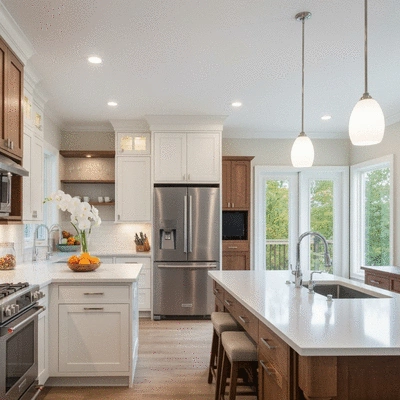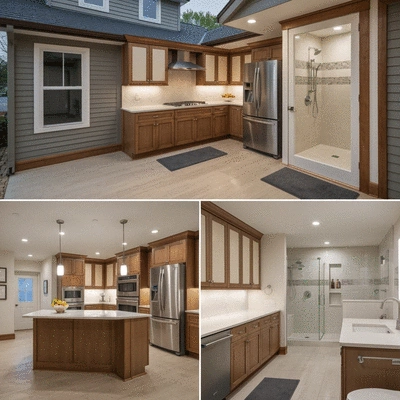
What if the secret to a perfect home remodel lies in the delicate balance between quality and cost? Understanding this balance can empower homeowners to make more informed decisions, ensuring their renovations are both beautiful and sustainable.
An overview of factors influencing home remodeling decisions, comparing DIY and professional approaches.

In this section, we’ll dive into what defines quality in remodeling projects and the costs associated with DIY versus professional services. Understanding these components can empower you to make informed decisions that enhance your space without breaking the bank.
Quality in home remodeling encompasses several factors that go beyond just the aesthetics. It’s about craftsmanship, materials, and the end result’s functionality. Let’s break down what makes a remodeling project truly high-quality!
Quality isn’t just about what meets the eye; it’s about ensuring that your remodel functions as well as it looks. After all, who wants to deal with a shoddy renovation down the line?
Investing in quality workmanship brings numerous long-term benefits. For starters, a well-executed remodel can increase your home’s resale value significantly. Homebuyers are often willing to pay more for a property that doesn’t require immediate repairs. Furthermore, quality projects tend to require fewer repairs over time, which means less maintenance and stress for you!
Additionally, high-quality renovations can lead to greater energy efficiency. For instance, good insulation and high-quality windows can lower your energy bills, providing savings long after the remodel is complete. To learn more about how home improvements can affect energy use, the U.S. Department of Energy offers valuable insights into deciding between DIY and professional help for energy-saving upgrades.
One of the most critical aspects of achieving quality is selecting the right materials. While it might be tempting to go for the cheapest options, remember that quality materials can often save you money in the long run.
Choosing quality materials may involve a bit more investment upfront, but it’s a decision that pays off in durability and aesthetic appeal. Always consider the return on investment when selecting materials for your home The National Association of Home Builders (NAHB) provides resources and information on quality construction practices and materials that can help inform your decisions.
Now that we’ve established what quality means, let’s take a closer look at evaluating the costs involved in DIY projects versus hiring professionals. It’s a crucial step that can significantly impact your remodeling journey!
DIY can be an enticing option for homeowners looking to save money. However, many don’t account for the full scope of costs. When calculating the true cost of a DIY project, consider these factors:
Ultimately, while DIY might seem like a cost-effective solution, it can become expensive if not approached carefully. Make sure to weigh these costs before committing For homeowners exploring renovation options, the U.S. Department of Housing and Urban Development (HUD) offers guidance and resources on home improvement projects, including considerations for DIY versus professional services.
On the other hand, hiring professionals comes with its own set of costs. Understanding what drives these prices can help you make a better-informed decision. Here are some common factors that affect professional service pricing:
By understanding these factors, you can better evaluate whether hiring a professional aligns with your budget and quality expectations.
Before making final decisions, perform a cost-benefit analysis to weigh your options. List out the potential benefits of quality versus the costs of DIY or hiring professionals. This analysis should include:
With all this information, you can confidently assess which route is best for you. Remember, every remodeling project is unique, just like every homeowner's situation!

In the next section, we will explore strategies for making informed remodeling decisions, ensuring you choose the best path for your home project.
When selecting materials for your remodeling project, consider not only the upfront cost but also the long-term savings. Investing in high-quality, energy-efficient options may be more expensive initially, but they can significantly reduce your utility bills and maintenance costs over time. Always assess the return on investment before making your final choices!
Quality in home remodeling goes beyond visual appeal, encompassing superior craftsmanship, durable materials, functional design, and compliance with local building codes. It ensures the longevity and performance of the renovated space.
Quality workmanship leads to increased home resale value, fewer repairs, lower maintenance costs, and improved energy efficiency. These benefits result in long-term savings and a more comfortable living environment.
Not necessarily. While DIY projects can save on labor costs, they often involve hidden expenses such as tool rentals, material costs, significant time investment, and potential mistakes requiring rework or additional materials. A thorough cost-benefit analysis is crucial.
Professional service pricing is influenced by the contractor's experience, the overall scope and complexity of the project, the quality and type of materials used, and the cost of skilled labor. Experienced professionals often deliver superior results, justifying higher upfront costs.
Integrating energy-efficient solutions isn’t just good for the planet; it can also save you money in the long run. Here are a few energy-efficient options to consider:
As we wrap up our discussion on quality and cost in home remodeling, it’s essential to strike a balance that aligns with your vision and budget. Quality doesn’t have to mean breaking the bank; understanding what you truly value in your renovation can help you make choices that satisfy both quality and cost. Remember, it’s about enhancing your living space in a way that feels right for you!
When planning your remodeling project, always consider the long-term benefits of investing in quality materials and workmanship. While it might be tempting to cut corners, these choices can lead to greater expenses down the line. Prioritizing durable materials and skilled labor will often translate to lower maintenance costs and increased property value over time!
Finding the sweet spot between your budget and your expectations for quality can be a challenge. Here are some tips to ensure you’re making informed decisions:
By balancing your budget with realistic quality expectations, you can ensure that your remodeling project enhances your home without causing financial strain. Take the time to assess your needs, and you’ll be well on your way to achieving a renovation that you love!
Home renovations should be approached with a clear understanding of both quality and cost. As a homeowner myself, I’ve seen firsthand how thoughtful planning can lead to stunning transformations. It’s not just about what looks good today; it’s about how your choices will stand the test of time. So, whether you’re tackling a small project or a complete overhaul, keep these key points in mind!
One crucial aspect that often gets overlooked is energy efficiency. Integrating energy-efficient solutions isn’t just good for the planet; it can also save you money in the long run. Here are a few energy-efficient options to consider:
When you think about quality in remodeling, don't forget to factor in energy efficiency. It’s a win-win situation that provides comfort and savings while also boosting your home’s value!
Here is a quick recap of the important points discussed in the article:
At Home Remodeling Insights, led by Madeline Birch, we empower homeowners to confidently navigate remodeling decisions by providing clear, practical advice on DIY projects versus hiring professionals. Join us to make your home improvement journey informed and successful.
